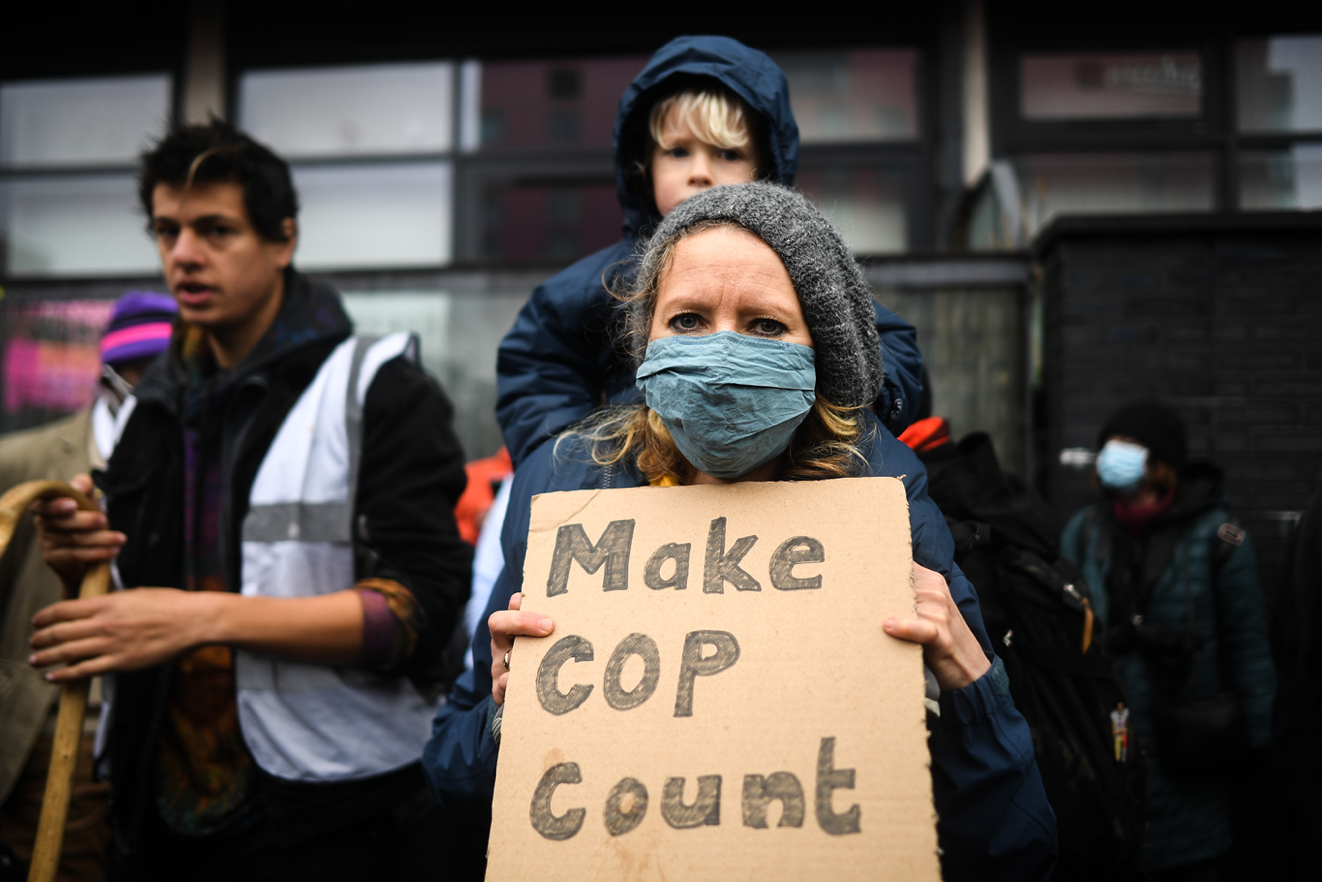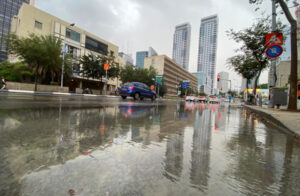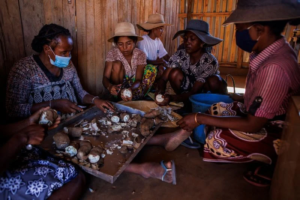As nations made ambitious and sometimes underwhelming pledges, their constituents at home were dealing with extreme heat, floods and more.
While many nations came together in Glasgow to discuss how to combat climate change, extreme weather didn’t stop back in their homelands. Each day, leaders spoke about the impact that rising global temperatures is having on their constituents — all while residents were often experiencing effects firsthand.
Here are some key conference and weather highlights day-by-day.
Monday, Nov. 1
Prime Minister Narendra Modi of India, the world’s third-largest greenhouse gas contributor, vowed to reach “net zero” emissions by 2070 — disappointing many climate advocates who wanted the nation to target an earlier date. India, however, promised to meet half of its energy demands from renewable resources by 2030.
The announcement came during northeast monsoon season in South Asia. Heavy rains in India and Sri Lanka in October and November triggered fatal flash flooding and landslides. India receives most of its rain during monsoon, with flooding always a concern. However, research shows monsoonal rains, such as during the summer, will become heavier and more erratic due to global warming from rising greenhouse gas emissions.
Tuesday, Nov. 2
More than 100 countries signed the Global Methane Pledge, calling to reduce methane emissions by 30 percent by 2030. Methane is a greenhouse gas that is about 80 times more powerful than carbon dioxide at warming the planet in its first 20 years released in the atmosphere. Despite the large number of participators, China and Russia, some of the largest methane emitters, had not signed the pledge.
More than 100 countries, including Brazil, also signed a pledge to halt deforestation by 2030.
Japan, which signed both agreements, experienced record-breaking rainfall the same day. On Nov. 2, the town of Kikonai in northern Japan’s Hokkaido set a national rainfall record: 2.2 inches (5.5 centimeters) in 10 minutes.
Wednesday, Nov. 3
Several organizations announced financial pledges to fund clean energy. A consortium of philanthropic foundations and international development banks pledged $10.5 billion to help emerging economies transition from fossil fuels to renewable energy sources, such as wind and solar. The Glasgow Financial Alliance for Net Zero, representing some of the biggest international banks, investors and insurers, also pledged $130 trillion to move the global economy to clean energy.
Meanwhile, southern Africa experienced exceptionally hot weather. Temperatures reached 111.6 degrees (44.2 Celsius) in Mozambique with another heat wave on the horizon. Botswana hit 108.9 degrees (42.7 Celsius), only one degree (0.6 Celsius) from its high in November. Comoros reached 95.9 degrees (35.5 Celsius), only (0.9 Celsius) shy of its all-time recorded high.
Rising temperatures and more frequent heat extremes have increased the rates of heat-related illnesses as well as exacerbating the spread of mosquito-borne diseases. Research suggests that sub-Saharan Africa could experience an additional 50 deaths per day from diseases such as malaria and dengue.
Thursday, Nov. 4
More than 20 other countries, including the United States, announced they would stop spending tax dollars to support international fossil fuel projects. The decision would restrict investments in drilling, power plants and projects by international development banks and publicly funded institutions, potentially freeing up $18 billion a year to invest toward clean energy.
Meanwhile, Uzbekistan experienced its worst dust storm in 150 years of monitoring. The dust began to settle on Nov. 4, but completely covered the country’s capital with a thick haze by the following day. The concentration of air dust, which contains harmful air particles when inhaled by people, was 30 times higher than what it considered acceptable for the area. The extreme dust event was triggered after months of drought as well as record-breaking temperatures in the summer.
Friday, Nov. 5
More than 25,000 adults and children, led by Greta Thunberg, marched on the streets of Glasgow in a “Fridays for Future” demonstration. Thunberg called COP26 a “failure” and “a global north green wash festival,” stating they need drastic annual emission cuts unlike ever before.
Meanwhile, eastern Asia was experiencing a warmer start to November. Shenyang in northeast China tied its monthly record at 67.6 degrees (19.8 Celsius), while North Korea experienced temperatures above 68 degrees (20 Celsius).
Saturday. Nov. 6
The most popular and interesting stories of the day to keep you in the know. In your inbox, every day.
In the largest protest of the climate summit, more than 100,000 people marched through the rain and wind in Glasgow urging for more climate action — a stark contrast to the quieter conference halls where the negotiations were taking place.
Northern Africa also experienced a stark contrast in weather. Morocco had its first frosts and snowfalls in the highlands with a low of 40.8 degrees (4.9 Celsius) at low elevations. On the eastern coast, Sirte, Libya reached 100.4 degrees (38 Celsius).
Sunday, Nov. 7
While the COP26 agenda listed Sunday as “rest day,” the U.S. Southeast experienced exceptionally high levels of coastal flooding from a strong offshore storm. Water levels reached highs that are rarely seen outside of hurricanes, although higher tides and flooding are occurring more often with rising sea levels induced by global warming.
Fort Pulaski, out of Savannah, Ga., observed its fourth-highest water level on record on Nov. 7. The Charleston Harbor reached its tenth highest level in the past 100 years of records. The high water shut down several roads, entered homes and businesses and canceled a Veteran’s day parade.
Monday, Nov. 8
Former president Barack Obama spoke at COP26 and affirmed the United States’ involvement in combating and adapting to climate change, while criticizing China and Russia for their inattentiveness to the “existential” problem.
Meanwhile, an unusually early cold spell over the weekend swept over China and brought record snowfall to some areas. The city of Shenyang recorded around 20 inches (51 centimeters) of snowfall — the highest in 116 years. Trains, bus stations, portions of highways were shut. Beijing turned on central heating nine days earlier than usual.
Although the warming climate is generally anticipated to reduce cold extremes and snowfall, some research suggests it may more frequently disturb the polar vortex and dislodge frigid, stormy weather patterns from the Arctic into the mid-latitudes.
Tuesday, Nov. 9
As COP26 pledges come in, a preliminary analysis by United Nations researchers show the short-term promises are not aggressive enough to meet long-term net zero goals. The new commitments to zero out emissions by the end of the century would only lead to about 0.1 degrees of warming less than before the conference started.
Meanwhile, Mozambique hit 113.9 degrees (45.5 Celsius), tying the highest temperature in the Southern Hemisphere so far this season.
Wednesday, Nov. 10
COP26 organizers released a draft of an agreement on how nations will curb climate change together. The draft called for countries to speed up their emission cuts and made direct references to phasing out coal and subsidies for fossil fuels, language that was omitted from the Paris agreement.
The United States and China, the world’s two biggest greenhouse gas emitters, also said they will work together to slow global warming this decade.
Meanwhile, Australia braced for potentially record rainfall and flooding near Queensland and New South Wales. The Queensland coast received 13.4 inches (34 centimeters) in 24 hours. Parts of New South Wales were forecast to receive more than one month’s worth of rain in just three days.
Thursday, Nov. 11
Nearing the last official day of the conference, negotiations are still underway. At the moment, the planet is still projected to exceed 1.5 degrees of warming by a full degree. COP26 President Alok Sharma said, “There is still a lot more work to be done.”
Meanwhile, a heat wave is taking over parts of California and sending temperatures over 90 degrees (32 Celsius) in November. San Bernardino, Chino and Camarillo hit 93 (33.9 Celsius).
Friday, Nov. 12
It’s the last official day of the conference, but countries are still negotiating rules for carbon markets, financial support for vulnerable nations and conditions for phasing out fossil fuel subsidies.
While high temperatures bake southern California, the Pacific Northwest is being drenched by heavy rain from an atmospheric river. Several atmospheric rivers in recent weeks has brought between 15 and 30 inches of rain in the past month along with flooding, debris flows and mudslides.




